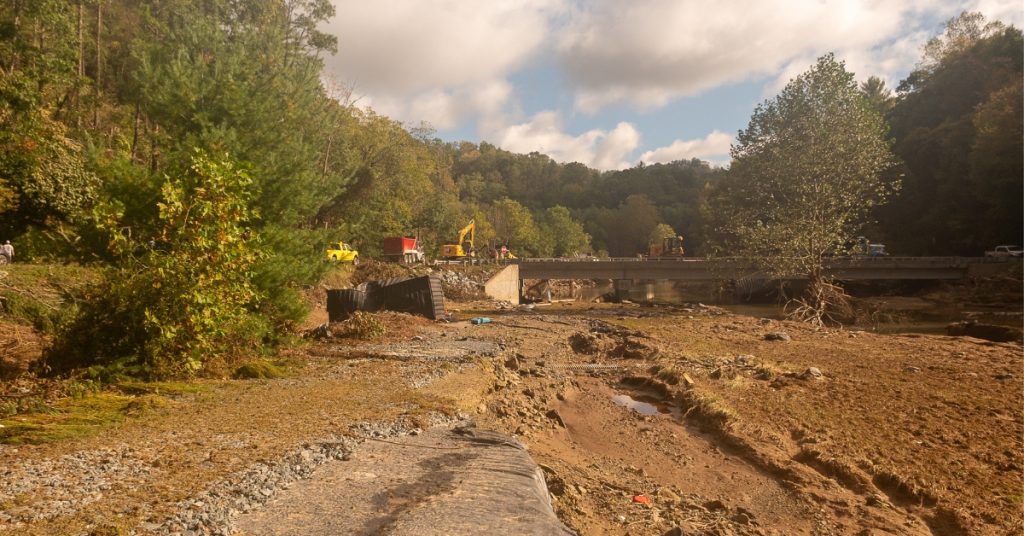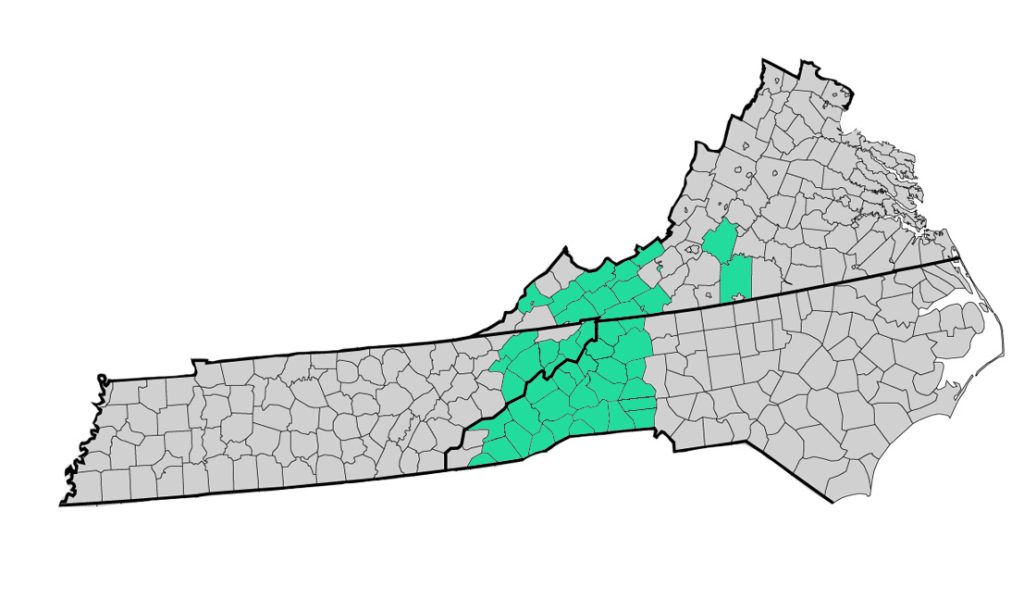Front Porch Blog

Hurricane Helene made landfall in Florida’s Big Bend region late in the evening on Sept. 26 as a Category 4 hurricane, making it one of the most powerful hurricanes to ever hit the United States. Over the following weekend, Helene was downgraded to a tropical storm and moved inland up the Appalachian Mountains, causing unprecedented damage in Georgia, the Carolinas, Tennessee and Virginia. Helene hit the region after sustained rain throughout the preceding week, bringing a total of 30 inches of rain in some areas and causing record-breaking flooding.
We are heartbroken by the losses across Appalachia and the Southeast, as so many families have had their worlds turned upside down, and whole communities are struggling to access basic necessities. For information on ways to receive support and ways to provide help to others, please see our Helene Relief webpage.
As our region recovers from this devastating storm, we understand you may have some questions regarding the process for federal assistance. This blog is meant to explain the process for a presidential disaster declaration and what this all means for your community, and to answer several common questions we’re seeing.
Common FEMA questions
Does FEMA have the money to support me and my community?
FEMA currently has enough funding to respond to the impacts of Hurricane Helene. Congress provided funding to FEMA and the Disaster Relief Fund in the law passed at the end of September to avoid a government shutdown.
However, there are real concerns that Congress only provided the bare minimum in funding to FEMA with two more months of hurricane season to go. The scale of damage from Hurricane Helene is staggering, and the damage in Florida from Hurricane Milton is expected to be severe. If demands on the Disaster Relief Fund begin to outpace the account balance, FEMA enters “immediate needs funding” which focuses on continuing “lifesaving and life-sustaining efforts.” Immediate needs funding continues providing critical individual assistance, but suspends new public assistance requests that support community clean-up and recovery activities that can restore utilities, roads and other public infrastructure.
If you are interested in telling Congress to return to DC and pass additional FEMA funding so that your community can continue recovering from this disaster uninterrupted, you can write to your representative and senators here. Appalachian Voices joined more than 80 organizations in sending a letter to congressional leaders with this request on Oct. 8.
Is $750 all that’s available per person, and do I have to pay that back?
No. The $750 individual payments are from a new FEMA program called “serious needs assistance.” Serious needs assistance provides an initial direct payment intended to help cover emergency supplies like food, water, baby formula and other basics. Serious needs assistance is meant to be a first payment to cover immediate concerns.
Additionally, the $750 payment does not need to be paid back and does not preclude you from qualifying for additional FEMA aid. FEMA disaster assistance is a tax-free payment. Accepting FEMA assistance does not affect your Social Security benefits, Medicare, Medicaid, Supplemental Nutrition Assistance Program (SNAP) or other federal assistance programs.
What You’ll Need When You Apply:
- A current phone number where you can be contacted.
- Your address at the time of the disaster and the address where you are now staying.
- Your Social Security number.
- A general list of damage and losses.
- Banking information if you choose direct deposit.
- If insured, the policy number or the agent and/or the company name.
- If you have homeowners, renters or flood insurance, you should file a claim as soon as possible. FEMA cannot duplicate benefits for losses covered by insurance. If your policy does not cover all your disaster expenses, you may be eligible for federal assistance.
If I accept assistance from FEMA, does that give FEMA ownership of my property?
No. Accepting FEMA assistance does not give FEMA ownership of your property. If you apply for individual assistance for home repairs, a federal inspector may visit your home to complete an assessment to inform FEMA’s decision on your assistance application, but they are not there to take your property.
How an area becomes eligible for FEMA assistance

How does a presidential disaster declaration typically work?
The Robert T. Stafford Disaster Relief and Emergency Assistance Act, signed into law in 1988, is the governing law for most federal disaster assistance programs, including the presidential disaster declaration process.
Say, for example, a tornado moves through an area and causes extensive damage. After the storm, the governor of the state would submit a request to their regional Federal Emergency Management Agency office to conduct a joint FEMA-state preliminary damage assessment. This assesses the extent of the storm, its impact on individuals and public facilities and the types of federal assistance that may be needed. This process can take about a month to complete and examines specific costs of recovery to determine if the state or local governments require federal support.
If the assessment confirms the extent of the storm exceeds state and local resources, the governor may submit a disaster declaration request to the president through the FEMA regional office. This request identifies specific counties in the state that need federal assistance and what kind of aid they need. Once the president approves the disaster declaration request, those impacted by the disaster are eligible for certain federal assistance programs.
If you have to wait on a damage assessment, how did states already have federal assistance when Helene moved through the area?

Alabama, Florida, Georgia, North Carolina, South Carolina, Tennessee and Virginia all had federal emergency declarations that were approved by President Joe Biden before or soon after they were impacted by Helene.
Governors can request emergency declarations to mobilize federal resources in response to a major event that requires federal assistance (whether funding or expertise/staffing). While emergency declarations can occur for other events aside from weather-driven disasters, they can be utilized to prepare for the impacts of a major weather event like an incoming hurricane. Emergency declarations mainly provide support to local and state governments in responding to the event, and do not typically cover individual assistance.
Governors may even request a major disaster declaration before a damage assessment is completed. This is not a standard practice, but it is allowed when something as significant as a Category 4 hurricane has recently passed through a community, and the projected damage exceeds state and local resources.
Florida, Georgia, North Carolina, South Carolina, Tennessee and Virginia all received expedited disaster declarations just days after Helene hit to unlock additional federal resources in the response and recovery phases. Comparatively, Vermont experienced severe flooding at the end of July 2024 and received approval for its major disaster declaration two months later at the end of September.

What can I do if my community was not included in the state’s disaster declaration?
If you believe that your community should have been included in your governor’s disaster declaration request, there is some good news: These are living documents that can be updated. Reach out to your local government and governor’s office to make your case and request a preliminary damage assessment for your community. If the assessment confirms the extent of damage needs federal support, the governor’s office may request a change to the original disaster declaration. The deadline for a governor to request this change is 30 days after the end of the disaster, which is currently listed as “continuing” for all impacted states on FEMA’s website.
What do you get from a disaster declaration?
A federal disaster declaration opens access to three types of federal funding: individual assistance, public assistance, and hazard mitigation assistance.
Individual assistance is for the people impacted by the disaster. Individual assistance includes things like housing and unemployment benefits, counseling services, and nutrition assistance. It is worth noting that the current maximum amount of individual assistance for repairing and restoring a home is $42,500 per household, with an additional $42,500 that may be available for a variety of other personal expenses related to the disaster. FEMA updates these limits annually based on the consumer price index.
Contact your governor
Click on the link for a contact form, or phone the office:
North Carolina: (919) 814-2000
Tennessee: (615) 741-2001
Virginia: (804) 786-2211
Public assistance is federal funding for state and local governments to complete debris cleanup activities and replace/restore public infrastructure like utilities, water treatment services, and roads and bridges.
Hazard mitigation assistance provides funding for long-term recovery projects that decrease the risk of a similar event impacting the community again in the future.
Additionally, the president may increase the percentage of funding the federal government provides. The federal government usually provides 75% of the costs for response and recovery activities, with the state and local governments picking up the other 25%. In response to Helene, Biden approved a 100% federal cost share for emergency response activities in Florida, Georgia, North Carolina, South Carolina, Tennessee and Virginia. This action completely alleviates the burden on state and local governments for paying for things like debris removal, first responders, search and rescue, shelters, and food services.
If you are unsure if you are eligible for federal assistance, you can review the designated areas in each state’s disaster declaration, linked below.
PREVIOUS
NEXT

Leave a comment
Your email address will not be published. Required fields are marked *
One response to “Making sense of the federal disaster declaration process for Hurricane Helene”
-
https://appvoices.org/2024/10/09/fema-questions/
Has the state been declared an emergency disaster by the governing offices in order for the Hurricane Helene populations to receive the recovery services that are desperately need on all levels.

Leave a Comment